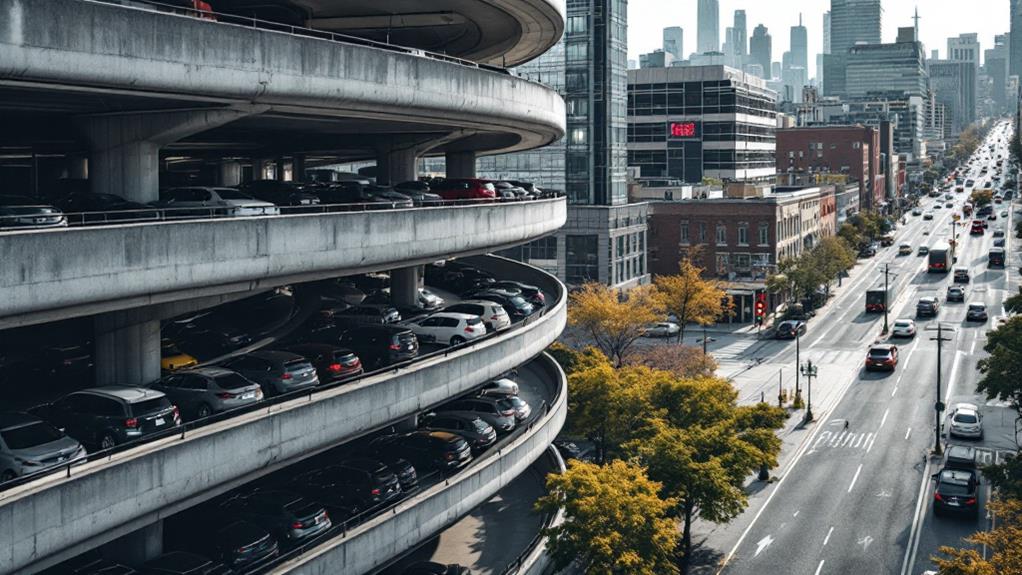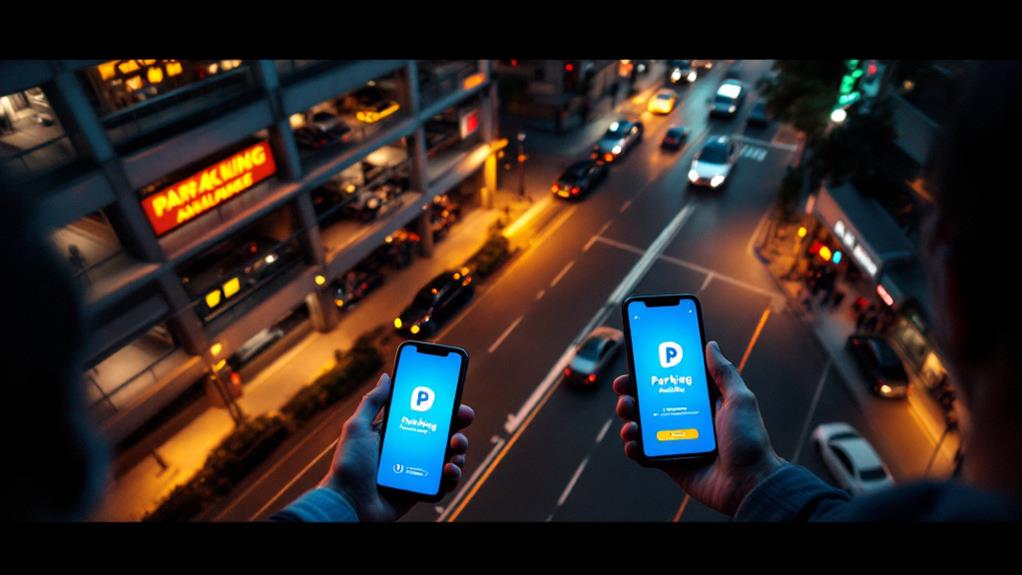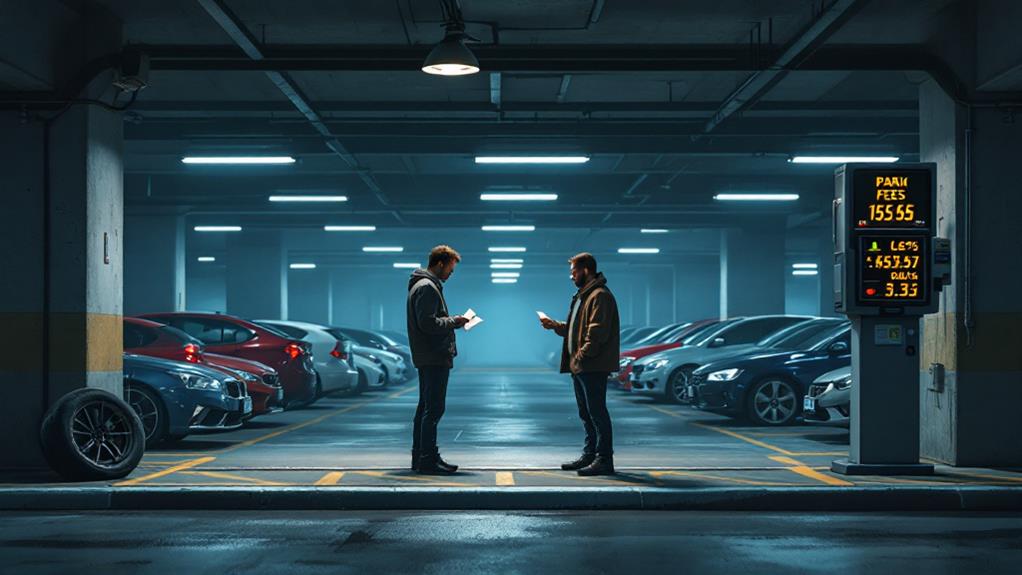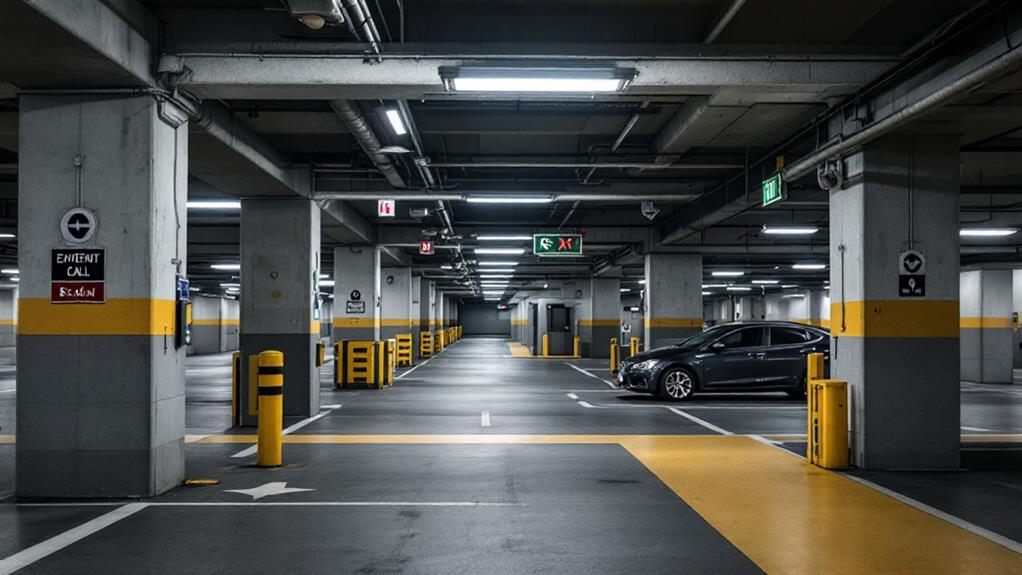How Public Parking Garages Help With Traffic Congestion

Public parking garages greatly reduce traffic congestion in urban areas. They decrease on-street parking demand, freeing up road space for smoother traffic flow. Smart technologies in these garages provide real-time availability information, minimizing time spent searching for parking. This efficient space utilization can cut urban traffic by up to 30%. Strategic urban planning integrates garages with public transit, encouraging multimodal transportation. During events, garages help manage traffic through pre-paid reservations and coordinated routing plans. By centralizing parking, they also reduce pollution and emissions from circling vehicles. The benefits of public parking garages extend far beyond just providing a place to park your car.
Reducing Street Parking Demand
Public parking garages frequently play an essential role in reducing street parking demand, thereby easing traffic congestion in urban areas. When you provide ample off-street parking spaces in these garages, you're effectively decreasing the need for on-street parking. This shift frees up important road space, allowing for smoother traffic flow and less congestion.
Studies have shown that up to 30% of urban traffic is caused by drivers searching for on-street parking. By offering convenient alternatives in parking garages, you're addressing this issue head-on. Furthermore, you can implement pricing strategies in these garages to encourage turnover, discouraging long-term parking on city streets and further reducing congestion.
To maximize the benefits of parking garages, you should strategically locate them near major destinations. This approach incentivizes drivers to park off-street instead of contributing to on-street gridlock. Additionally, integrating real-time parking availability information from these garages into routing applications helps drivers quickly find open spots, reducing unnecessary cruising and emissions. By leveraging public parking garages effectively, you're not just providing parking spaces; you're actively contributing to a more efficient and less congested urban environment.
Efficient Space Utilization
Through efficient space utilization, public parking garages can significantly reduce traffic congestion in urban areas. These parking facilities employ innovative technologies and strategies to maximize their capacity and streamline the parking process for drivers.
You'll find that sensor-enabled parking garages are at the forefront of modern parking solutions. These systems use real-time occupancy monitoring to guide you quickly to available spaces, eliminating the need for time-consuming searches. This efficiency reduces the number of vehicles circling blocks and contributing to traffic congestion.
Dynamic pricing is another key feature of these smart parking facilities. By adjusting rates based on demand, you're encouraged to park during off-peak hours, leading to a more even distribution of vehicle traffic throughout the day. This approach helps alleviate congestion during traditionally busy periods.
Optimized layouts and traffic flow patterns within garages also play an essential role. You'll experience smoother entry and exit processes, minimizing the impact on surrounding roads. Additionally, integration with smart city infrastructure and mobility apps allows you to plan your parking in advance, further reducing unnecessary traffic on city streets.
Real-Time Availability Information

With real-time availability information, public parking garages are revolutionizing the way you find and secure parking spots in busy urban areas. Sensor data and digital signage provide up-to-the-minute details on available spaces, helping you quickly locate a spot and reduce time spent circling the block. This technology-driven approach not only saves you time but also helps alleviate traffic congestion on city streets.
Integration of real-time parking data into navigation apps enables you to plan your routes more efficiently, avoiding congestion caused by searching for elusive parking spots. Cities can now manage parking demand and optimize existing infrastructure through smart parking solutions that centralize occupancy data.
- Minimizes time spent searching for parking
- Reduces fuel consumption and emissions
- Alleviates traffic congestion in urban areas
- Empowers local authorities to make data-driven decisions
Strategic Urban Planning
Strategic urban planning takes the concept of real-time parking information to the next level, addressing traffic congestion extensively. By integrating public parking garages into a broader vision for sustainable cities, you'll see a shift towards more efficient transportation systems and reduced reliance on personal vehicles.
Cities can reduce traffic congestion by implementing parking reform policies, such as lowering minimum parking requirements and introducing variable pricing. These strategies discourage excessive car use while promoting alternative modes of transport. You'll notice an increase in public transportation options, cycling networks, and pedestrian-friendly spaces as cities repurpose road space for non-automotive uses.
To achieve these goals, collaboration between urban planners, transportation authorities, and the parking industry is indispensable. They'll work together to create integrated solutions that balance parking needs with sustainable mobility options. You'll benefit from improved public transit connections to parking facilities, making it easier to combine different modes of transportation for your daily commute.
Event Traffic Management

Four key strategies can effectively manage event traffic and reduce congestion around public parking garages. When large events occur at stadiums or venues, the resulting traffic can overwhelm local infrastructure and require additional police management. To mitigate these issues, you'll want to implement coordinated parking management solutions that optimize traffic flow and improve the overall event experience.
- Encourage pre-paid parking reservations
- Integrate smart transportation options
- Employ real-time traffic monitoring systems
- Implement strategic traffic routing plans
Pollution and Emissions Reduction
Public parking garages play an essential role in reducing pollution and emissions in urban areas. By providing centralized parking options, these structures help minimize the time you spend circling city blocks looking for parking. This decrease in cruising time directly translates to lower vehicle emissions and improved air quality in your neighborhood.
Smart parking technologies in garages offer real-time availability data, cutting your search time by an estimated 64% per vehicle. This significant reduction in idle driving reduces congestion and, consequently, lowers automotive emissions. Additionally, garages that implement changing pricing strategies better distribute parking demand throughout the day, further alleviating traffic congestion and its associated environmental impacts.
You'll find that many modern parking garages are integrating sustainable transit options. By offering bike-sharing stations and electric vehicle charging points, these facilities encourage eco-friendly transportation choices. This integration enhances the role of public parking garages in mitigating the environmental effects of private vehicle use. As cities work to improve air quality and reduce their carbon footprint, well-managed parking garages emerge as a pivotal tool in combating urban pollution and emissions.
Integration With Public Transit

Building on the environmental benefits of public parking garages, their integration with public transit systems amplifies their positive impact on urban mobility. By connecting these facilities to bus and train networks, cities can encourage multimodal transportation, reducing individual car usage and improving overall traffic flow.
You'll find several advantages to this integration:
- Discounted or free parking for transit users
- Strategic locations near transit hubs
- Real-time parking information in transit apps
- Extended reach of public transportation
When you park your car in a garage connected to public transit, you're not just saving time and money; you're contributing to a more efficient urban transportation system. By eliminating the need for searching for parking in congested areas, you're helping to reduce traffic on city streets.
These integrated systems make it easier for you to plan your travel, combining driving and public transit for optimal proficiency. With real-time parking availability information at your fingertips, you can make informed decisions about your travel route, further streamlining your commute and reducing overall congestion in the city.
Economic Benefits for Cities
Prosperity flows from well-managed public parking facilities, offering cities a multitude of economic advantages. You'll find that well-designed public garages generate significant revenue through parking fees and taxes, providing essential funding for infrastructure and public services. This income stream can be a transformative force for urban development and maintenance.
Smart parking solutions in public garages can reduce congestion by minimizing the time drivers spend searching for spots. This efficiency not only improves the urban experience but also decreases emissions, contributing to cleaner city air. Furthermore, by freeing up precious street-level real estate, cities gain the potential to reduce on-street parking and repurpose that space for pedestrian-friendly areas, bike lanes, or transit improvements.
Public-private partnerships offer another avenue for economic growth. These collaborations can capitalize on private investment to expand parking capacity while maintaining public control over policy. By integrating multimodal transportation options within parking structures, you're encouraging a shift away from single-occupancy vehicle use, further alleviating traffic congestion and promoting sustainable urban mobility.



